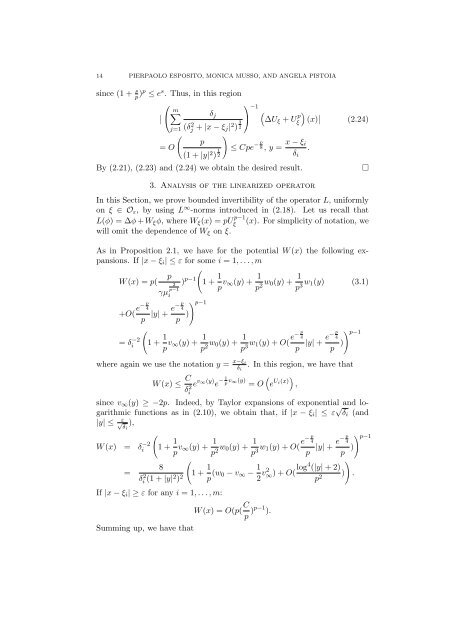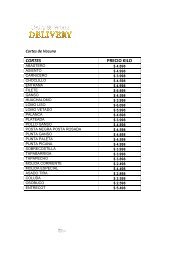CONCENTRATING SOLUTIONS FOR A PLANAR ... - CAPDE
CONCENTRATING SOLUTIONS FOR A PLANAR ... - CAPDE
CONCENTRATING SOLUTIONS FOR A PLANAR ... - CAPDE
Create successful ePaper yourself
Turn your PDF publications into a flip-book with our unique Google optimized e-Paper software.
14 PIERPAOLO ESPOSITO, MONICA MUSSO, AND ANGELA PISTOIA<br />
since (1 + s p )p ≤ e s . Thus, in this region<br />
⎛<br />
⎞−1 m∑<br />
∣<br />
δ ( )<br />
⎝<br />
j ⎠<br />
j=1 (δj 2 + |x − ξ ∆U<br />
j| 2 ) 3 ξ + U p ξ<br />
(x) ∣ (2.24)<br />
2<br />
(<br />
)<br />
p<br />
= O<br />
≤ Cpe − p x − ξ i<br />
(1 + |y| 2 ) 1 8 , y = .<br />
2<br />
δ i<br />
By (2.21), (2.23) and (2.24) we obtain the desired result.<br />
3. Analysis of the linearized operator<br />
In this Section, we prove bounded invertibility of the operator L, uniformly<br />
on ξ ∈ O ε , by using L ∞ -norms introduced in (2.18). Let us recall that<br />
L(φ) = ∆φ + W ξ φ, where W ξ (x) = pU p−1<br />
ξ<br />
(x). For simplicity of notation, we<br />
will omit the dependence of W ξ on ξ.<br />
As in Proposition 2.1, we have for the potential W (x) the following expansions.<br />
If |x − ξ i | ≤ ε for some i = 1, . . . , m<br />
p<br />
W (x) = p(<br />
γµ<br />
2<br />
p−1<br />
i<br />
+O( e− p 4<br />
p |y| + e− p 4<br />
p ) ) p−1<br />
= δ −2<br />
i<br />
(<br />
) p−1 (1 + 1 p v ∞(y) + 1 p 2 w 0(y) + 1 p 3 w 1(y) (3.1)<br />
1 + 1 p v ∞(y) + 1 p 2 w 0(y) + 1 p 3 w 1(y) + O( e− p 4<br />
p |y| + e− p 4<br />
p ) ) p−1<br />
where again we use the notation y = x−ξ i<br />
δ i<br />
. In this region, we have that<br />
W (x) ≤ C δi<br />
2 e v∞(y) e − 1 p v∞(y) ( )<br />
= O e U i(x)<br />
,<br />
since v ∞ (y) ≥ −2p. Indeed, by Taylor expansions of exponential and logarithmic<br />
functions as in (2.10), we obtain that, if |x − ξ i | ≤ ε √ δ i (and<br />
|y| ≤ √ ε<br />
δi<br />
),<br />
W (x) = δ −2<br />
i<br />
=<br />
(<br />
1 + 1 p v ∞(y) + 1 p 2 w 0(y) + 1 p 3 w 1(y) + O( e− p 4<br />
p |y| + e− p 4<br />
p ) ) p−1<br />
(<br />
8<br />
δi 2(1 + |y|2 ) 2 1 + 1 p (w 0 − v ∞ − 1 2 v2 ∞) + O( log4 (|y| + 2)<br />
p 2 )<br />
If |x − ξ i | ≥ ε for any i = 1, . . . , m:<br />
Summing up, we have that<br />
W (x) = O(p( C p )p−1 ).<br />
)<br />
.<br />
□





